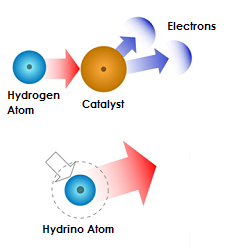Ever heard of a hydrino? It is a form of shrunken hydrogen. Hydrogen is the first element in the periodic table. So you ask, how can you make hydrogen atoms even smaller? Well apparently you can by exposing them to ions, that is atoms that have lost an electron. These ions are called catalytic because they cause the hydrogen to shrink and release energy. How much energy depends on how many catalytic ions are involved in interacting with the hydrogen.
The theory that hydrogen could be shrunk to form hydrinos was first described in 1986. The energy net gain from multiple collisions with catalytic ions could continuously shrink the hydrogen into smaller and smaller hydrinos with each shrinking releasing enormous amounts of energy. We know that hydrogen when combined with oxygen to form a water molecule releases 2.5 electron volts (eVs). Hydrinos can release much higher levels than 2.5 eVs as they shrink from collisions resulting in an net energy yield. What does this all mean? That water could be a fuel, and since our planet surface is more than 70% covered by water we could have a source of unlimited potential.
This theory of hydrinos as a power source is suddenly in the news. A company, Blacklight Power Inc., in New Jersey, has just issued a release claiming that independent experts from six academic and industry laboratories validated its technology, the production of electricity from the conversion of water vapour to hydrinos. Blacklight believes that hydrinos may be the dark matter that scientists speculate makes up most of the mass of the universe.

The company has developed a proprietary technology it calls the Catalyst Induced Hydrino Transition cell or CIHT. A CIHT extracts energy from water vapour in the air. It does this with much higher energy yields and at a much smaller cost than conventional hydrogen fuel cells. And unlike a fuel cell it doesn’t require the burning of fossil fuels to generate the chemical reaction that initiates the process. In fact it doesn’t require any fuel source other than that to initiate electrolysis for extracting hydrogen from water to get the process started. Once the hydrogen to hydrino cycle initiates water becomes the ongoing fuel source generating a continuous output of energy.
Blacklight reports that the independent studies involved groups of scientists who fabricated and tested CIHT cells, operating them for periods of from 30 to 70 days. The analysis of the results validates the company’s claim that it can run its cell technology on water vapour and produce a net electrical output 1o+ times greater than the energy required to initiate the electrolytic process.
The potential of the energy yield of a single CIHT cell could operate a standard mid-sized automobile for 5,000 kilometers (approximately 3,000 miles) on a liter of water (0.26 U.S. gallons). A 133-liter cell would be capable of delivering 200 kilowatts or 267 horsepower while weighing one-third that of an equivalent internal combustion engine with a net benefit of producing no carbon pollutants.
If Blacklight continues to get validation from third parties and can bring CIHT cells to market then mark May 22, 2012 as an important milestone in our human search for unlimited energy resources that come with no negative environmental impact.








